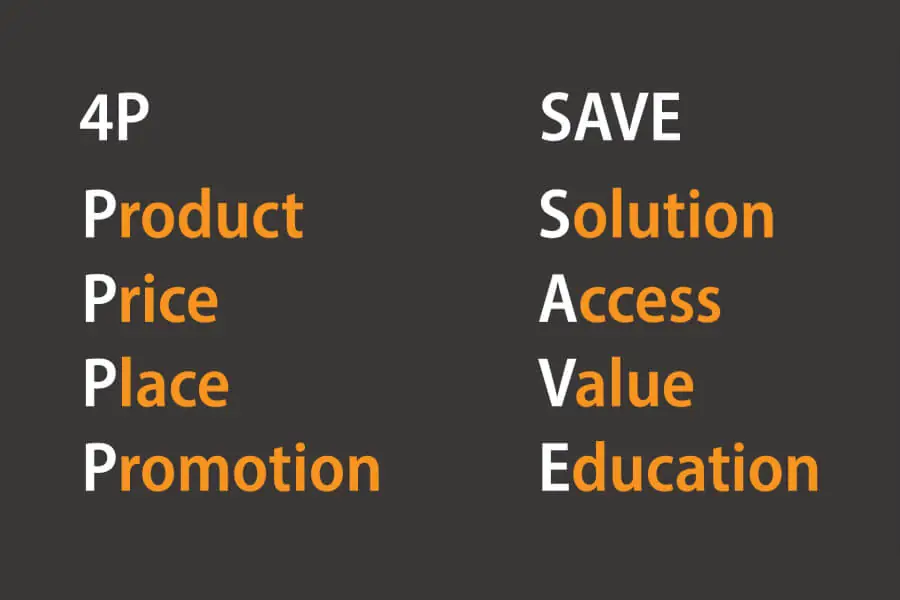The SAVE Model: A Replacement for the 4Ps in B2B Marketing


As the landscape of B2B marketing continues to evolve, there’s an increased demand for models that align more closely with today’s business challenges and priorities. While the time-honored 4Ps (Product, Price, Place, and Promotion) have long served as the backbone for marketing strategies, the SAVE model, introduced by Eduardo Conrado of Motorola, emerges as a more tailored approach for modern B2B marketing.
Table of Contents
In this article, we delve into the intricacies of the SAVE model, examining its potential to supersede the traditional 4Ps in the B2B sphere.
What is the Save Model?
The SAVE model is a marketing framework that focuses on providing solutions to customers, making products and services accessible, demonstrating value, and educating customers. It is a more customer-centric approach to marketing than the traditional 4Ps (product, price, place, and promotion).


1. Solution Over Product
Traditional marketing relied on the ‘Product’ pillar, emphasizing tangible and intangible offerings. However, in a B2B context, companies don’t just seek products; they yearn for solutions to their intricate challenges. The SAVE model pivots to ‘Solutions’, which ensures a deeper alignment with the client’s objectives. For instance, a cloud software provider isn’t just selling software, but offering a solution for efficient data storage, retrieval, and collaboration.
2. Access Over Place
While ‘Place’ in the 4Ps looked at distribution points, ‘Access’ in the SAVE model underscores the importance of customer engagement across all preferred communication channels. In the digital age, with the proliferation of platforms and devices, it’s not just about where your product can be found, but how accessible and user-friendly it is across various touchpoints. Cisco, for example, has mastered this by providing its users seamless access to its products and services online, across various devices and platforms.
3. Value Over Price
In B2B, the pricing conversation shifts from just the cost to the value proposition. The ‘Value’ component in SAVE challenges businesses to showcase their ROI clearly. This involves both tangible returns, like cost savings, and intangible benefits, like enhancing brand reputation or facilitating better internal communication. IBM’s approach, emphasizing the value of their cloud solutions in terms of security, scalability, and integration capabilities, serves as a prime example.
4. Education Over Promotion
Promotion, in traditional marketing, largely leaned on advertising and pushing messages to the audience. However, the B2B sector, characterized by informed and discerning clients, demands more than just promotions. ‘Education’ in SAVE underscores the role of content marketing and thought leadership. Brands are now publishers, disseminating insightful content to guide, inform, and educate potential clients. Deloitte, through its extensive repository of whitepapers, research, and case studies, exemplifies this shift.
Strategies for Implementing the SAVE Method in a B2B Business
Implementing the SAVE (Solution, Access, Value, Education) method requires a paradigm shift from traditional marketing tactics. It’s about aligning your offerings more closely with the specific needs and preferences of B2B customers. Here are a few actionable strategies for businesses looking to transition to this model:
1. Transitioning from Product to Solution
- Deep Dive into Client Needs: Before offering a solution, deeply understand the client’s challenges. Engage in regular feedback sessions, industry forums, and surveys.
- Customized Offerings: Rather than offering a one-size-fits-all product, adapt your offering to suit the unique challenges faced by different industries or businesses.
- Collaborative Product Development: Engage key clients in your product development process, co-creating solutions that directly address their needs.
2. Prioritizing Access over Place
- Multi-channel Strategy: Ensure that clients can interact with your business seamlessly across various platforms, whether it’s through your website, mobile app, or third-party platforms.
- Customer Support: Offer 24/7 customer support, ensuring that clients have instant access to assistance when they need it.
- Optimized User Experience: Regularly test and optimize your platforms, ensuring that information is easy to find, the purchasing process is seamless, and technical issues are minimal.
3. Emphasizing Value over Price
- Transparent ROI Communication: Clearly showcase the ROI of your solution, providing concrete metrics and case studies as evidence.
- Bundle Offerings: Combine complementary services or products, offering comprehensive packages that provide greater value than individual components.
- Flexible Pricing Models: Consider offering tiered pricing, subscription models, or performance-based pricing to cater to the varying budgets and needs of your B2B clients.
4. Leading with Education instead of Promotion
- Content Marketing: Develop a content strategy centered around educating your target audience. Offer webinars, whitepapers, case studies, and how-to guides relevant to your industry.
- Thought Leadership: Position your company’s leaders as industry experts. Engage in speaking opportunities, podcasts, or guest writing for prominent industry publications.
- Engage in Workshops and Training: Offer workshops, training sessions, or product demos, enabling potential clients to see firsthand how your solution addresses their challenges.
Transitioning to the SAVE method in B2B marketing is not just about changing tactics—it’s about shifting your entire approach to align more closely with the unique needs and challenges of B2B clients. By prioritizing solutions, ensuring accessibility, emphasizing value, and leading with education, businesses can cultivate deeper, more meaningful relationships with their clients and position themselves as indispensable partners rather than just vendors.
GlobalSense Marketing helps Taiwan Manufacturers develop tailored marketing solutions to drive success in international markets. Call us today to learn more.
